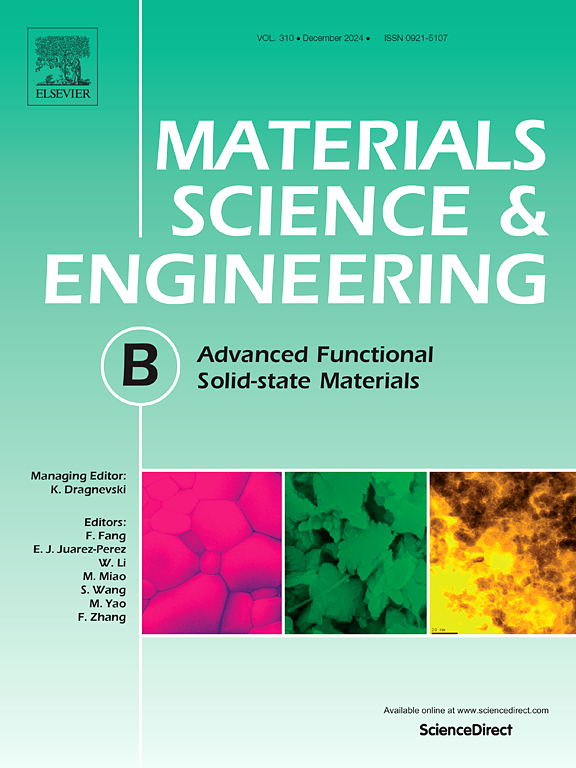CuAgBeGeSe4/c-Si单片串联太阳能电池的高开路电压(>1.9 eV)和效率(> 32%)的数值研究
IF 4.6
3区 材料科学
Q2 MATERIALS SCIENCE, MULTIDISCIPLINARY
引用次数: 0
摘要
由于带隙的限制,单结太阳能电池的光电转换效率(PCE)不能突破自身的理论效率。与单结太阳能电池相比,多结太阳能电池具有较宽的阳光吸收范围和较高的PCE,本文提出了一种新型的双端硫族碱串联太阳能电池。为了实现这种新型串联太阳能电池的最佳效率,我们分别选择带隙为1.58 eV的CuAgBeGeSe4 (CABGSe)和带隙为1.12 eV的传统晶体硅(c-Si)作为顶部电池和底部电池的吸收材料,并利用SCAPS-1D软件对这种CABGSe/c-Si串联太阳能电池(TSC)进行了结构模拟和优化。在独立照明条件下,对CABGSe顶部电池和c-Si底部电池进行了升级,效率分别达到20.17%和25.79%。基于单结太阳能电池获得的最优参数,进一步分析了CABGSe/c-Si TSC的电流匹配条件。结果表明,当吸收层厚度分别为2.5 μm和335 μm时,匹配电流为18.54 mA/cm2。此时,CABGSe/c-Si TSC的开路电压、填充系数和效率分别为1.98 V、87.94%和32.12%。研究结果为高性能太阳能电池的研发提供了有益的参考,有望在未来太阳能光伏领域进一步提高能量转换效率。本文章由计算机程序翻译,如有差异,请以英文原文为准。
CuAgBeGeSe4/c-Si monolithic tandem solar cell with high open-circuit voltage (>1.9 eV) and efficiency (>32 %): A numerical study
The photoelectric conversion efficiency (PCE) of unijunction solar cells cannot break through its own theoretical efficiency because of the limitation of the band gap. Relative to unijunction solar cells, multijunction solar cells have a wide sunlight absorption range and exhibit high PCE. This work proposes a novel two-terminal chalcogenide-base tandem solar cell. To achieve the optimal efficiency from this new tandem design, we selected CuAgBeGeSe4 (CABGSe) with a band gap of 1.58 eV and the traditional crystalline silicon (c-Si) with a band gap of 1.12 eV as the absorber materials for the top cell and the bottom cell respectively, and utilized the SCAPS-1D software to conduct structural simulation and optimization on this CABGSe/c-Si tandem solar cell (TSC). Under an independent illumination condition, the CABGSe top cell and the c-Si bottom cell are upgraded to achieve an efficiency of 20.17 % and 25.79 %, respectively. Based on the optimal parameters obtained from unijunction solar cells, the matching condition of electric currents of the CABGSe/c-Si TSC is further analyzed. The results show that the best matched current, 18.54 mA/cm2, can be obtained when the thicknesses of the absorbing layers of the CABGSe top cell and the c-Si bottom cell are 2.5 μm and 335 μm, respectively. At this point, the open-circuit voltage, fill factor, and efficiency of CABGSe/c-Si TSC are 1.98 V, 87.94 %, and 32.12 %, respectively. The research results provide a useful reference for the research and development of high-performance solar cells and are expected to further improve the energy conversion efficiency in the future solar photovoltaic field.
求助全文
通过发布文献求助,成功后即可免费获取论文全文。
去求助
来源期刊

Materials Science and Engineering: B
工程技术-材料科学:综合
CiteScore
5.60
自引率
2.80%
发文量
481
审稿时长
3.5 months
期刊介绍:
The journal provides an international medium for the publication of theoretical and experimental studies and reviews related to the electronic, electrochemical, ionic, magnetic, optical, and biosensing properties of solid state materials in bulk, thin film and particulate forms. Papers dealing with synthesis, processing, characterization, structure, physical properties and computational aspects of nano-crystalline, crystalline, amorphous and glassy forms of ceramics, semiconductors, layered insertion compounds, low-dimensional compounds and systems, fast-ion conductors, polymers and dielectrics are viewed as suitable for publication. Articles focused on nano-structured aspects of these advanced solid-state materials will also be considered suitable.
 求助内容:
求助内容: 应助结果提醒方式:
应助结果提醒方式:


